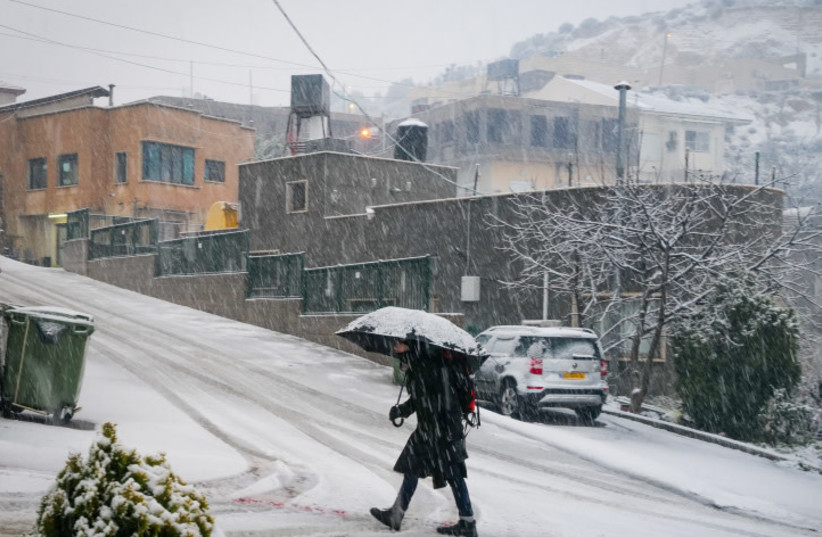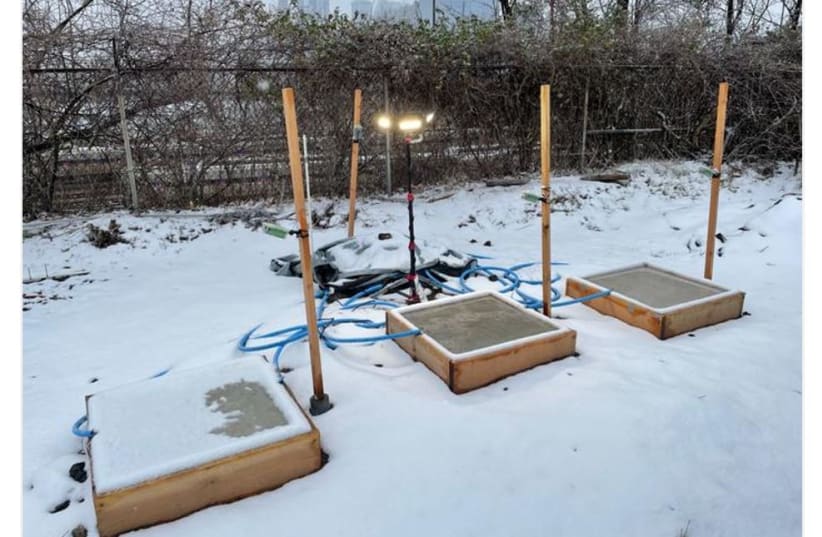Clearing roads and sidewalks of snow with mechanical snowplows and salt to lower temperatures at which it melts is a very expensive procedure, and they often seriously harm the concrete and asphalt. Now, researchers at Drexel University in Philadelphia are coming closer to making such a chore obsolete.
Tucked inconspicuously next to a parking lot for the university’s facilities vehicles, two 76 by 76-centimeter slabs have been warding off snow, sleet and freezing rain on their own – without shoveling, salting or scraping – for over three years. Researchers recently reported on the science behind special concrete they developed that can warm itself up when it snows or as temperatures approach freezing.
The self-heating concrete is the latest in an ongoing effort to create more environmentally responsive and resilient infrastructure, particularly in the northern regions of the US, where the National Highway Administration estimates that cold states spend $2.3 billion on snow and ice-removal operations each year and millions to repair roadways damaged by winter weather.
The Golan Heights, Upper Galilee, Jerusalem, Gush Etzion, and other locations in Israel spend large amounts of money and mechanical shovels to clear the roads in winter.
“One way to extend the service life of a concrete surfaces, like roadways, is to help them maintain a surface temperature above freezing during the winter,” said civil engineering Prof. Amir Yaghoob Farnam who has been leading the research. “Preventing freezing and thawing and cutting back on the need for plowing and salting are good ways to keep the surface from deteriorating. So, our work is looking at how we can incorporate special materials in the concrete that help it to maintain a higher surface temperature when the ambient temperature around it drops.”

Team has been developing the tech for five years
The Drexel team has been developing its cold-weather-resilient concrete mix over the last five years. Until now, the success of their self-heating concrete – which they have previously reported can melt snow and prevent or slow ice formation for an extended period of time – has been only in a controlled lab setting. In a paper just published in the American Society for Civil Engineering’s Journal of Materials in Civil Engineering under the title “Development of Self-Heating Concrete Using Low-Temperature Phase Change Materials: Multiscale and In Situ Real-Time Evaluation of Snow-Melting and Freeze–Thaw Performance,” the group took the important step of proving its viability in the natural environment.
“We have demonstrated that our self-heating concrete is capable of melting snow on its own, using only the environmental daytime thermal energy and doing it without the help of salt, shoveling, or heating systems,” Farnam said. The self-heating concrete is suitable for mountainous and northern regions in the US such as Northeast Pennsylvania and Philadelphia and in snowy countries abroad where there are suitable heating and cooling cycles in winter.
The secret to the concrete’s warming is low-temperature liquid paraffin, which releases heat when it turns from its room-temperature state as a liquid to a solid when temperatures drop.
One method they devised involves treating porous lightweight aggregate – pebbles and small stone fragments that are ingredients in concrete –with the paraffin. The aggregate absorbs the liquid paraffin before being mixed into the concrete. The other strategy is mixing micro-capsules of paraffin directly into the concrete.
The researchers poured one slab using each method and a third without any phase-change material, as a control. All three have been outside in the elements since December 2021. In the first two years, they faced a total of 32 freeze-thaw events — instances where temperature dropped below freezing, regardless of precipitation and five snowfalls of 2.5 centimeters or more.
Using cameras and thermal sensors, the researchers monitored the temperature and snow and ice-melting behavior of the slabs. The heating is enough to melt five centimeters of snow, at a rate of about a quarter of an .5 centimeters of snow per hour. And while this may not be warm enough to melt a heavy snow event before plows are needed, it can help de-ice the road surface and increase transportation safety even in heavy snow events.
Simply preventing the surface from dropping below freezing also goes a long way when it comes to preventing deterioration, according to the researchers.
“Freeze-thaw cycles, periods of extreme cooling – below freezing – and warming, can cause a surface to expand and contract in size, which puts a strain on its structural integrity and can cause damaging cracking and spalling over time,” said doctoral student Robin Deb who helped lead the research. “One of the promising findings is that the slabs with phase-change materials were able to stabilize their temperature above freezing when faced with dropping ambient temperatures.”
Overall, the treated lightweight aggregate slab performed better at sustaining its heating, keeping the temperature above freezing for up to 10 hours.
“Our findings suggest that the phase-change material treated lightweight aggregate concrete was more suited for de-icing applications at sub-zero temperatures due to its gradual heat release within wider range of temperature,” Farnam said.
“With these findings, we will be able to continue to improve the system to one day optimize it for longer heating and greater melting. We planto continue to collect data on the slabs to understand the long-term effectiveness of the phase-change materials and study how this method may extend the lifespan of concrete,” the team concluded.

